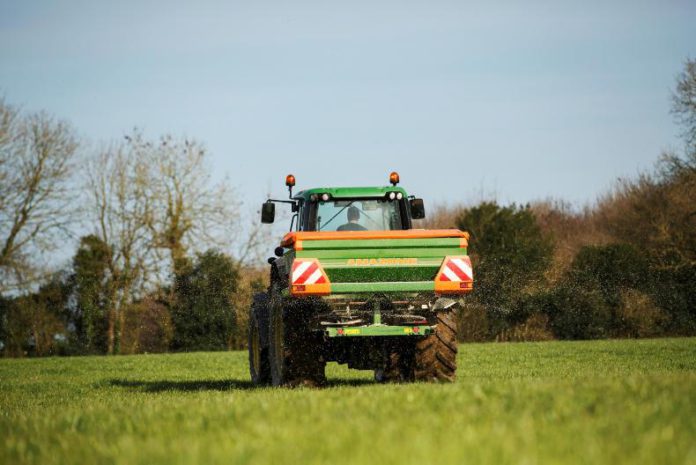Protected urea is cheaper than CAN on a cost per kg of nitrogen basis, writes Niall Treanor, B&T Drystock Adviser, Teagasc Galway/Clare.
While it may appear slightly dearer than ordinary urea, it will give the same ‘effective N’ as urea, at a 12.5% lower spreading rate.
Table 1 summarises the N lost from the three N fertiliser products as ammonia and nitrous oxide nitrogen gases.

The EPA estimates that ammonia loss from urea is 15.5% on average.
Both it and CAN having lower rates of N loss (79% reduction for protected urea = 3.3% loss; 85% reduction for CAN = 2.3% loss).
Published research has quantified direct N loss as nitrous oxide from urea (0.25%), protected urea (0.4%) and CAN (1.49%).
In summary, it curtails N losses by reducing:
- Ammonia N emissions compared with straight urea;
- Nitrous oxide N emissions compared to CAN.
This would make protected urea more cost-effective than both urea and CAN as spread.
While the cost per kg of nitrogen is cheapest for straight urea (Table 2), when the extra losses associated with straight urea are accounted for, protected urea is cheaper.

Example 1
Assuming a rate of 50 kg of N spread as protected urea or 50 kg of N spread as CAN in March 2022.
The equivalent quantity of N as straight urea that would need to be spread is 57kg, allowing for the extra losses with straight urea.
If we assume costs of urea = €950/t, protected urea = €1,000/t, CAN = €750/t, Table 2 highlights the difference in cost with protected urea being the cheapest option.
Table 3: Relative cost per kg N for different fertiliser types

At these prices, the farmer will get better value for money by using protected urea (as opposed to urea).
The example above, using current fertiliser prices, shows that the extra cost of the urease inhibitor more than covers its cost, if it saves 7 kg of N.
The value of retaining N that had previously been lost as ammonia has increased dramatically in line with the increased fertiliser cost.
Also, in a situation where N application rate is limited, it makes sense to use less of a more effective product.
The quantity of grass grown by using CAN, protected urea and urea will be similar across all fertiliser types.
The quantity of grass grown:

In a long-term trial at Johnstown Castle, the grass grown by the protected urea was 13% ahead of urea on average over 6 years (drought year excluded).
By switching to 100% protected urea on dairy farms, total farm emissions have the potential to be reduced by 7-8% at a spreading rate of between 200 to 250 kg N/ ha.
The equivalent savings on total emissions on suckler farms is 1-2%, at a spreading rate of 60 to 80 kg N/ ha.
You may need to use straight P and K fertilisers or blends such as 07-30 or 010-20 with protected urea to balance nutrient requirements.

Other articles:





